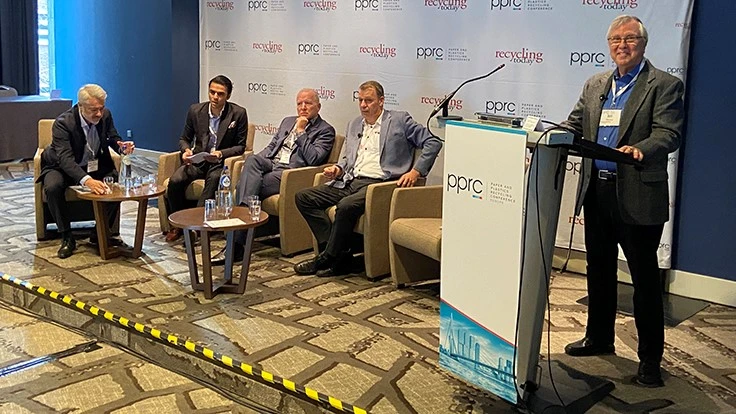
Recycling Today archives
Producers of packaging board, tissue and other types of paper remain eager to maintain or boost their use of recovered fiber, according to mill buyers who formed a panel at the 2022 Paper & Plastic Recycling Conference Europe, held in mid-November in Rotterdam.
Bill Moore of United States-based consultancy Moore & Associates said of the role of paper mill recovered fiber buyers, “The best mill buyers are always working on developing supply, but it takes time. It’s like an annuity: it pays off year after year.” Based on portrayals from four mill buyers who joined Moore at a conference session, that aspect of their jobs will remain vital.
Hans Wortman of Germany-based tissue maker WEPA said his company’s mills customarily seek discarded graphic paper grades—a fast-shrinking source of supply—as feedstock. Nonetheless, the company has committed to increasing its use of recovered paper from 40 percent to 60 percent of feedstock.
One way WEPA is doing that is by producing tissue products that are light brown rather than bright white in appearance. This allows WEPA to tap into the more abundant old corrugated containers (OCC) grade.
“We are hopeful it will attract customers,” Wortman said of the nonwhite tissue products. “We think this is a bold step for the tissue industry.”
Ireland-based packaging producer Smurfit Kappa Group (SKG) has long procured OCC and has every plan to continue doing so, said Leon Graff, who is based in the Netherlands for the firm. Graff said SKG anticipates ongoing competitive bidding for OCC, making an analogy to the game of chess. “At every point, you have to judge the situation, and it is complex,” he said.
Graff said SKG is investing to move more material via the European barge and canal system, saying there are decarbonization, cost savings and favorable logistics aspects to the shift. He said this is a viable shift in the Netherlands, where the canal system is extensive. In the United Kingdom and Germany, SKG is instead seeking to use more rail transport as a way to cut down on truck emissions and expenses.
While some of SKG’s recovered paper buying competition is in Europe, some also comes from overseas. Representing that segment on the panel was Abilbfazal Jani, of United Arab Emirates-based Paper Link International and India-based Jani Sales Pvt. Ltd. The former firm procures recovered paper while the latter operates a mill in India.
Jani said pending waste directive changes in the European Union could reduce Paper Link’s presence in that market. The firm currently sources considerable tonnage in the U.K., and Jani said he will be spending 2023 seeking to improve the company’s access to North American material. He said the kraft paper sector in India is growing quickly, while the tissue sector is “developing.”
A new competitor for OCC and other packaging recovered fiber grades in Europe is a Norske Skog paper machine in Golbey, France. The Norway-based company is in the process of converting a line that used to make newsprint into one that will make corrugated fluting and testliner, said Jean-Francois Serre of Norske Skog Golbey.
Once the conversion process in Golbey is completed, Serre said its new fluting and testliner line will require up to 600,000 tons per year of OCC while its existing tissue line will seek more than 330,000 tons per year of recovered paper to make 100-percent-recycled-content tissue.
The panelists listed high energy costs, truck driver shortages and plastic contaminants in recovered fiber bales as among the challenges they are facing currently.
Wortman said the 4Evergreen campaign being championed by the Confederation of European Paper Industries (CEPI) is geared in part to address that third challenge. According to Wortman, 4Evergreen is providing design-for-recycling and recyclability testing services intended to help packaging firms and brand owners put products on shelves that are welcome at paper mills.
Regarding some new paper-based forms of packaging (which often use layered or mixed materials), Wortman said, “How do you collect it and sort it? This is what worries me. When paper is taken to the landfill or incinerator, that is devastating to the industry.”
The 2022 Paper & Plastics Recycling Conference Europe event was Nov. 15-16 at the Hilton Rotterdam in the Netherlands.
Latest from Recycling Today
- BMW Group, Encory launch 'direct recycling’ of batteries
- Loom Carbon, RTI International partner to scale textile recycling technology
- Goodwill Industries of West Michigan, American Glass Mosaics partner to divert glass from landfill
- CARI forms federal advocacy partnership
- Monthly packaging papers shipments down in November
- STEEL Act aims to enhance trade enforcement to prevent dumping of steel in the US
- San Francisco schools introduce compostable lunch trays
- Aduro graduates from Shell GameChanger program





